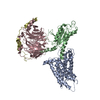+検索条件
-Structure paper
| タイトル | The tethered peptide activation mechanism of adhesion GPCRs. |
|---|---|
| ジャーナル・号・ページ | Nature, Vol. 604, Issue 7907, Page 757-762, Year 2022 |
| 掲載日 | 2022年4月13日 |
 著者 著者 | Ximena Barros-Álvarez / Robert M Nwokonko / Alexander Vizurraga / Donna Matzov / Feng He / Makaía M Papasergi-Scott / Michael J Robertson / Ouliana Panova / Eliane Hadas Yardeni / Alpay B Seven / Frank E Kwarcinski / Hongyu Su / Maria Claudia Peroto / Justin G Meyerowitz / Moran Shalev-Benami / Gregory G Tall / Georgios Skiniotis /   |
| PubMed 要旨 | Adhesion G-protein-coupled receptors (aGPCRs) are characterized by the presence of auto-proteolysing extracellular regions that are involved in cell-cell and cell-extracellular matrix interactions. ...Adhesion G-protein-coupled receptors (aGPCRs) are characterized by the presence of auto-proteolysing extracellular regions that are involved in cell-cell and cell-extracellular matrix interactions. Self cleavage within the aGPCR auto-proteolysis-inducing (GAIN) domain produces two protomers-N-terminal and C-terminal fragments-that remain non-covalently attached after receptors reach the cell surface. Upon dissociation of the N-terminal fragment, the C-terminus of the GAIN domain acts as a tethered agonist (TA) peptide to activate the seven-transmembrane domain with a mechanism that has been poorly understood. Here we provide cryo-electron microscopy snapshots of two distinct members of the aGPCR family, GPR56 (also known as ADGRG1) and latrophilin 3 (LPHN3 (also known as ADGRL3)). Low-resolution maps of the receptors in their N-terminal fragment-bound state indicate that the GAIN domain projects flexibly towards the extracellular space, keeping the encrypted TA peptide away from the seven-transmembrane domain. High-resolution structures of GPR56 and LPHN3 in their active, G-protein-coupled states, reveal that after dissociation of the extracellular region, the decrypted TA peptides engage the seven-transmembrane domain core with a notable conservation of interactions that also involve extracellular loop 2. TA binding stabilizes breaks in the middle of transmembrane helices 6 and 7 that facilitate aGPCR coupling and activation of heterotrimeric G proteins. Collectively, these results enable us to propose a general model for aGPCR activation. |
 リンク リンク |  Nature / Nature /  PubMed:35418682 / PubMed:35418682 /  PubMed Central PubMed Central |
| 手法 | EM (単粒子) |
| 解像度 | 2.7 - 2.9 Å |
| 構造データ | EMDB-25076, PDB-7sf7: EMDB-25077, PDB-7sf8: |
| 化合物 |  ChemComp-HOH: |
| 由来 |
|
 キーワード キーワード | MEMBRANE PROTEIN / Adhesion GPCR / LPHN3 / Latrophilin / ADGRL3 / tethered agonist / stalk / stachel / miniG13 / G13 heterotrimer / G protein / cryoEM / GPR56 / ADGRG1 |
 ムービー
ムービー コントローラー
コントローラー 構造ビューア
構造ビューア 万見文献について
万見文献について







 homo sapiens (ヒト)
homo sapiens (ヒト)